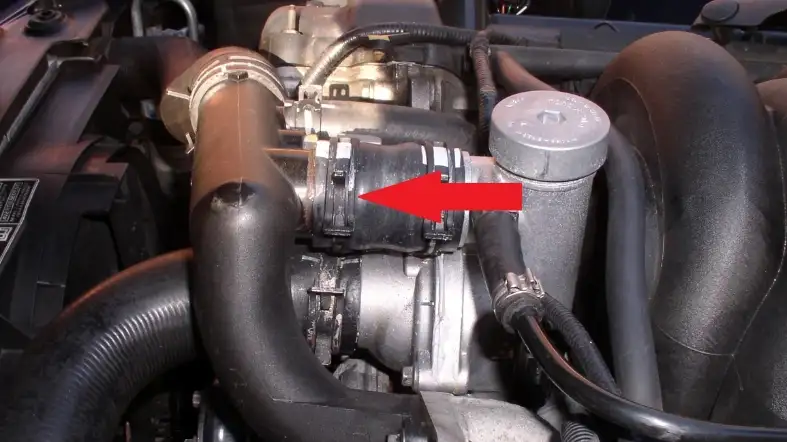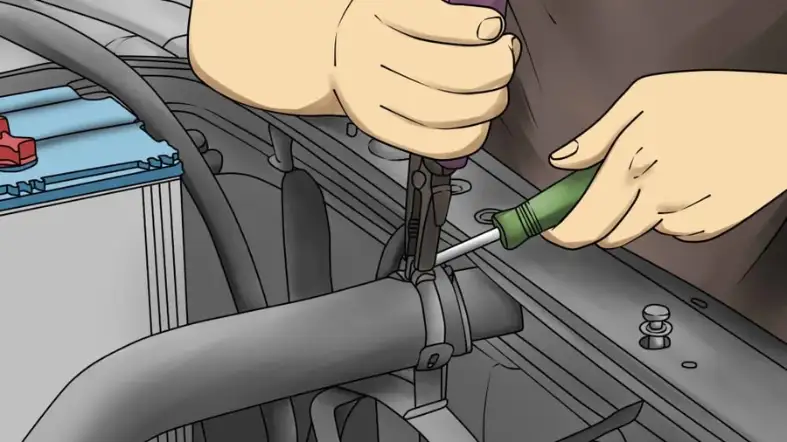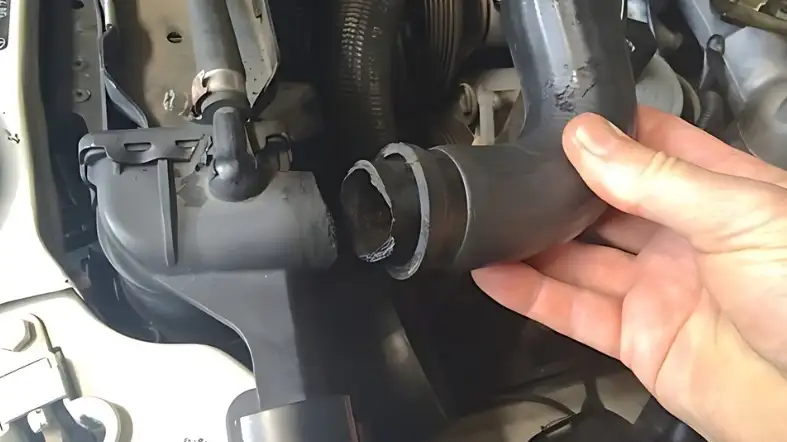If you have ever experienced the upper radiator hose popping off, you know how frustrating it can be.
Not only does it leave you stranded on the side of the road, but it can also cause significant engine damage.
While this issue can be caused by a variety of factors, it’s important to understand the root cause to prevent it from happening again.
In this blog post, we will explore the common causes of upper radiator hose failure and provide you with tips on how to troubleshoot and prevent this issue from occurring in the future.

Upper Radiator Hose Keeps Popping Off
If your upper radiator hose keeps popping off, it could be due to a number of reasons.
Firstly, it could be that the hose clamp is not tight enough or that it is worn out and needs replacing.
Check the hose clamp and ensure that it is tightened securely using a hose clamp plier.
Another possible reason could be that the hose itself is damaged or worn out or that it is improperly installed.
Check the hose for any signs of wear and tear, cracks, or splits. If the hose is damaged, it should be replaced immediately.
Reasons Why the Upper Radiator Hose Keeps Popping Off
Here are some potential reasons why the upper radiator hose might keep popping off:
Faulty Clamps:
One of the most common reasons for a radiator hose to keep popping off is due to faulty or worn-out clamps.
Over time, the clamps that hold the hose in place can become weakened, leading to a loose connection that can cause the hose to pop off.
Overheating:
If the engine is overheating, it can cause the pressure inside the cooling system to rise to a dangerous level, which can cause the radiator hose to pop off.
This can occur due to a variety of reasons, including a malfunctioning thermostat, a clogged radiator, or a blown head gasket.
Improper Installation:
If the radiator hose is not properly installed or is not the correct size for the engine, it can lead to a poor connection that may cause the hose to pop off.
Old or Worn-out Hose:
If the radiator hose is old or has become worn out due to exposure to heat and pressure, it may no longer be able to withstand the pressure inside the cooling system, causing it to pop off.
Engine Vibration:
Excessive engine vibration can cause the radiator hose to move around and become dislodged from its proper position, leading to it popping off.
How to Properly Install an Upper Radiator Hose?

Here are some steps to follow to install an upper radiator hose properly:
Gather Materials and Tools
Before starting, make sure you have the right materials and tools. You’ll need a new upper radiator hose, hose clamps, a screwdriver, and pliers.
Drain the Cooling System
To avoid spilling coolant, drain the cooling system before removing the old upper radiator hose. Follow the manufacturer’s instructions for draining the system.
Remove the Old Hose
Use pliers to loosen the hose clamps and remove the old upper radiator hose from the engine and radiator.
Clean the Connections
Use a clean cloth to wipe the connections on the engine and radiator to ensure that they are clean and free of debris.
Install the New Hose
Slide the new upper radiator hose onto the connections on the engine and radiator. Make sure that the hose is properly aligned and fully seated on the connections.
Secure the Hose with Clamps
Use a screwdriver to tighten the hose clamps securely on both ends of the new upper radiator hose.
Refill the Cooling System
Follow the manufacturer’s instructions to refill the cooling system with coolant.
Check for Leaks
Start the engine and let it run for a few minutes. Check for any leaks around the connections on the engine and radiator.
If you notice any leaks, turn off the engine and tighten the hose clamps as necessary.
How to Troubleshoot a Popping Upper Radiator Hose?

Here are some steps to follow to troubleshoot a popping upper radiator hose:
Check the Hose and Clamps
The first step is to check the hose and clamps for damage or wear.
Make sure that the clamps are securely tightened and that the hose is not cracked, split, or bulging. If the hose or clamps are damaged, replace them immediately.
Inspect the Thermostat
A faulty thermostat can cause overheating and put extra pressure on the upper radiator hose.
Check the thermostat to make sure it is working properly and replace it if necessary.
Check the Radiator Cap
A worn or damaged radiator cap can cause the upper radiator hose to pop off. Check the radiator cap for damage or wear and replace it if necessary.
Inspect the Radiator
A damaged or clogged radiator can cause overheating and put extra pressure on the upper radiator hose.
Inspect the radiator for damage, leaks, or clogs and replace or repair it as necessary.
Check the Water Pump
The water pump is responsible for circulating the coolant through the engine and radiator.
A faulty water pump can cause overheating and put extra pressure on the upper radiator hose.
Inspect the water pump for leaks, damage, or wear and replace it if necessary.
Verify Coolant Levels
Low coolant levels can cause the engine to overheat, which can put extra pressure on the upper radiator hose. Check the coolant levels and add coolant if necessary.
Verify System Pressure
If the cooling system is not pressurized properly, it can cause the upper radiator hose to pop off.
Use a pressure tester to check the system pressure and repair any leaks or damage.
Frequently Asked Questions
Q. What Is The Upper Radiator Hose?
A: The upper radiator hose connects the top of the radiator to the engine’s thermostat housing.
It carries hot coolant from the engine to the radiator, where it is cooled before returning to the engine.
Q. What Causes The Upper Radiator Hose To Pop Off?
A: There are several possible causes, including a loose hose clamp, a damaged hose, or a faulty thermostat.
Overheating can also cause the hose to expand and pop off.
Q. How Can I Prevent The Upper Radiator Hose From Popping Off?
A: Regular maintenance can help prevent the upper radiator hose from popping off.
This includes checking the hose and clamps for damage and ensuring that they are securely attached.
Keeping the cooling system clean and free of debris can also help prevent overheating.
Q. Can I Repair A Damaged Upper Radiator Hose?
A: If the hose is only slightly damaged, you may be able to repair it with a patch kit or sealant.
However, it’s usually best to replace the hose to ensure the proper functioning of the cooling system.
Q. What Should I Do If The Upper Radiator Hose Pops Off While Driving?
A: If the upper radiator hose pops off while you’re driving, you should pull over as soon as it is safe to do so and turn off the engine.
Allow the engine to cool down before attempting to reattach the hose.
If the hose cannot be reattached or appears to be damaged, have your vehicle towed to a mechanic.
Q. How Often Should I Replace The Upper Radiator Hose?
A: The upper radiator hose should be replaced every four to six years or as recommended by the manufacturer.
However, it’s important to regularly check the hose and clamps for damage and replace them as necessary.
Q. Can I Replace The Upper Radiator Hose Myself?
A: Replacing the upper radiator hose is a relatively simple task that can be done by most car owners with basic mechanical skills.
However, if you’re unsure about the process or don’t have the necessary tools, it’s best to have a professional mechanic replace the hose for you.
Conclusion:
The upper radiator hose is an essential component of your vehicle’s cooling system, and it’s crucial to ensure that it’s functioning correctly.
If you notice that the upper radiator hose keeps popping off, it’s essential to address the issue promptly to avoid significant engine damage.
By understanding the common causes of upper radiator hose failure and implementing preventative measures, you can keep your vehicle running smoothly and avoid the frustration of a sudden breakdown on the side of the road.
Remember, regular maintenance and timely repairs can save you time, money, and the headache of a malfunctioning vehicle.
